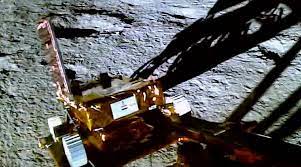In a groundbreaking discovery, the Pragyan rover, part of the Chandrayaan-3 mission, has unearthed an unexpected surprise on the moon – traces of sulphur. This revelation challenges our understanding of lunar geology and opens up new avenues for lunar exploration. The Chandrayaan-3 mission, a collaborative effort between the Indian Space Research Organisation (ISRO) and the Indian Institute of Astrophysics (IIA), has been making waves in the field of lunar science since its launch in August 2023.
Chandrayaan-3 Mission
The Chandrayaan-3 mission was designed to build on the success of its predecessors, Chandrayaan-1 and Chandrayaan-2, by exploring the south polar region of the moon. The mission aims to enhance our understanding of the moon’s geology, topography, and its potential for resources such as water ice.
Unexpected Discovery of Sulphur
The Pragyan rover, equipped with state-of-the-art scientific instruments, has been diligently exploring the lunar surface. However, its recent discovery of sulphur has taken scientists by surprise. Sulphur is not typically associated with the moon, and its presence raises intriguing questions about the moon’s history and formation.
Significance of the Discovery
The discovery of sulphur on the moon holds significant scientific implications. It challenges the conventional theories about the moon’s formation, which primarily revolve around the collision theory, suggesting that the moon was formed from the debris of a collision between Earth and a Mars-sized object.
New Theories on Lunar Formation
The presence of sulphur suggests that alternative theories about the moon’s formation may need to be considered. One possibility is that the moon may have retained some of its original volatile elements, including sulphur, from the solar nebula during its formation. This could provide insights into the moon’s early history and the conditions that prevailed in the solar system billions of years ago.
Lunar Sulphur and Future Lunar Exploration
The discovery of sulphur on the moon also has practical implications for future lunar exploration. Sulphur can potentially be utilized as a resource for future lunar missions, including the production of rocket propellant. This finding adds to the growing list of potential resources that could make sustainable lunar missions a reality.
International Collaboration
The Chandrayaan-3 mission’s success underscores the importance of international collaboration in space exploration. Scientists from around the world have been closely monitoring the mission’s progress and eagerly await further discoveries.
Future Prospects
As the Pragyan rover continues its exploration of the lunar surface, scientists are hopeful that more surprises await. The mission has already provided a wealth of data that will keep researchers busy for years to come. It is expected that the findings from Chandrayaan-3 will contribute to our broader understanding of lunar science and inform future lunar exploration missions.
The discovery of sulphur on the moon by the Pragyan rover has opened up new frontiers in lunar science. It challenges our existing theories about lunar formation and highlights the importance of continued exploration and international collaboration in space research. As the mission unfolds, scientists eagerly anticipate further revelations that will deepen our understanding of Earth’s celestial neighbor and pave the way for future lunar missions. Chandrayaan-3 has proven once again that the mysteries of the moon are far from being fully unraveled.








